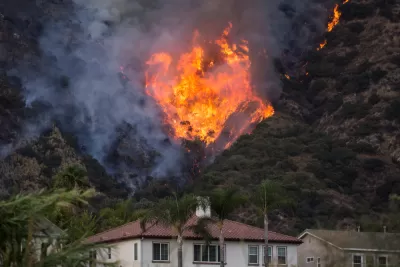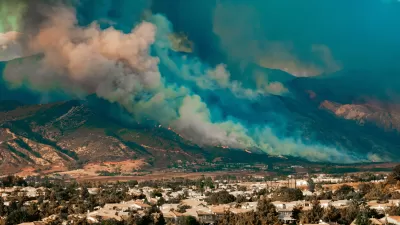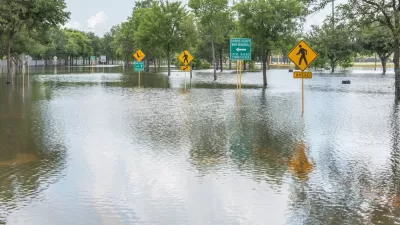Environmental risks are becoming too much for the home insurance industry to bear. Could this be the first signs of the collapse and reversal of sprawling land use patterns?

Los Angeles Times columnists Erika D. Smith and Anita Chabria write that California shouldn’t expect home insurers to stick around if the state continues to build in unsafe areas at constant risk for wildfires and extreme weather events.
“Our most vulnerable communities often lie in our most vulnerable regions: mountains marred by years of unprecedented wildfires, or Central Valley farm fields drowned in record rains and now epic snowmelt,” according to the column. The wake up call needed to reverse decades of sprawling development patterns, according to Smith and Chabria, might come from the home insurance industry.
According to previous coverage in the Los Angeles Times, State Farm General Insurance Co. announced recently that it would no longer accept new applications for property and casualty coverage in California because of wildfire and construction costs. Allstate Corp. also recently informed the state Department of Insurance that it stopped selling new home insurance policies last year. Allstate is also seeking a nearly 40% rate increase for home and business property and casualty insurance, according to the article.
Planetizen also picked up the news about insurers “fleeing” California, but it should be noted that insurers are also leaving Florida, where insurance premiums are already much higher than in California—and other states facing climate risks along coastlines or at wildland-urban interfaces shouldn’t expect to be spared the same drama forever.
According to the source article, linked below, California is still at risk of doubling down on sprawl, following years of historic housing legislation intended to spur new residential development.
“The problem is Newsom and his administration have required little oversight of where all this housing is being built. Nor have they communicated a cohesive philosophy about mitigating the current and future development risks linked to climate change,” write Smith and Chabria.
FULL STORY: Column: State Farm is right. California can’t keep building housing in high-risk places

Alabama: Trump Terminates Settlements for Black Communities Harmed By Raw Sewage
Trump deemed the landmark civil rights agreement “illegal DEI and environmental justice policy.”

Planetizen Federal Action Tracker
A weekly monitor of how Trump’s orders and actions are impacting planners and planning in America.

Why Should We Subsidize Public Transportation?
Many public transit agencies face financial stress due to rising costs, declining fare revenue, and declining subsidies. Transit advocates must provide a strong business case for increasing public transit funding.

Understanding Road Diets
An explainer from Momentum highlights the advantages of reducing vehicle lanes in favor of more bike, transit, and pedestrian infrastructure.

New California Law Regulates Warehouse Pollution
A new law tightens building and emissions regulations for large distribution warehouses to mitigate air pollution and traffic in surrounding communities.

Phoenix Announces Opening Date for Light Rail Extension
The South Central extension will connect South Phoenix to downtown and other major hubs starting on June 7.
Urban Design for Planners 1: Software Tools
This six-course series explores essential urban design concepts using open source software and equips planners with the tools they need to participate fully in the urban design process.
Planning for Universal Design
Learn the tools for implementing Universal Design in planning regulations.
Caltrans
Smith Gee Studio
Institute for Housing and Urban Development Studies (IHS)
City of Grandview
Harvard GSD Executive Education
Toledo-Lucas County Plan Commissions
Salt Lake City
NYU Wagner Graduate School of Public Service





























